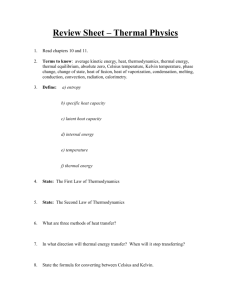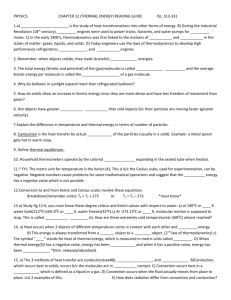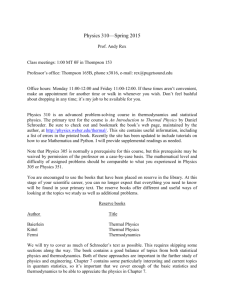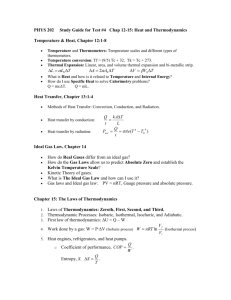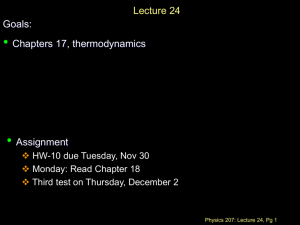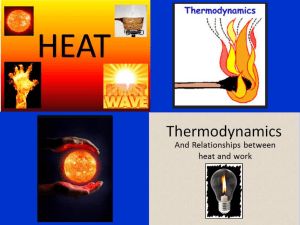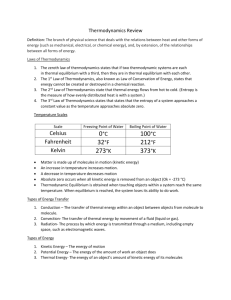Topic 10_1__Thermodynamics
advertisement
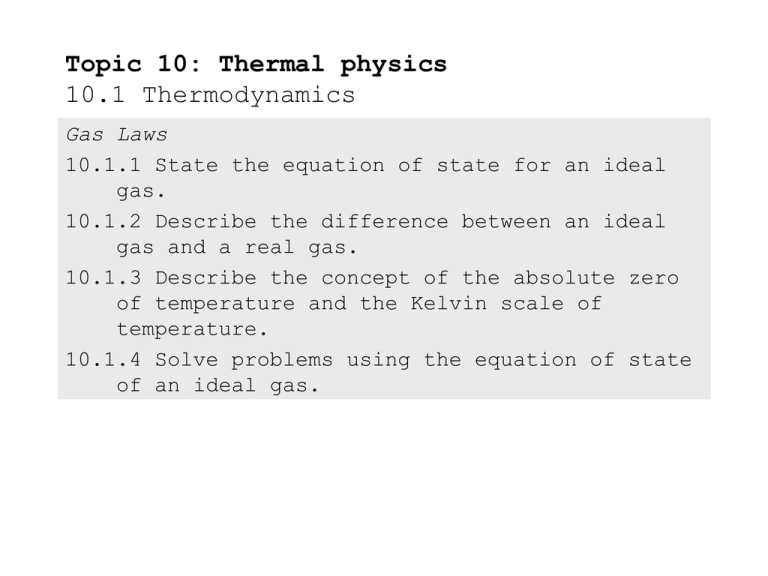
Topic 10: Thermal physics 10.1 Thermodynamics Gas Laws 10.1.1 State the equation of state for an ideal gas. 10.1.2 Describe the difference between an ideal gas and a real gas. 10.1.3 Describe the concept of the absolute zero of temperature and the Kelvin scale of temperature. 10.1.4 Solve problems using the equation of state of an ideal gas. Topic 10: Thermal physics 10.1 Thermodynamics Gas Laws State the equation of state for an ideal gas. PV = nRT R = 8.31 J/mol·K (universal gas constant) equation of state of an ideal gas We will explain what an ideal gas is soon. The variables P (pressure), V (volume), n (number of moles), and T (absolute temperature) are all called the state variables. Don’t forget the following: P = F/A pressure NA = 6.021023 molecules/mole Avagadro’s number FYI Topic 10 is an extension of Topic 3. Review it! Topic 10: Thermal physics 10.1 Thermodynamics Gas Laws Describe the difference between an ideal gas and a real gas. Recall the properties of an ideal gas. The molecules that make up an ideal gas… …are identical perfect spheres. …are perfectly elastic – they don’t lose any kinetic energy during their collisions with each other, or the walls of their container. …have no intermolecular forces – their potential energy does not change. …are so small that their volume is much smaller than the volume of their container. FYI This is the kinetic model of an ideal gas. Topic 10: Thermal physics 10.1 Thermodynamics Gas Laws Describe the difference between an ideal gas and a real gas. For a real gas… The molecules that make up a real gas… …are not identical perfect spheres. …are not perfectly elastic. …have intermolecular forces. …are relatively large. FYI Ideal gases cannot be liquefied, whereas real gases can. Real gases have intermolecular forces. Real gases are often polyatomic (N2, O2, H2O, NH4, etc.) and thus not spherical. Topic 10: Thermal physics 10.1 Thermodynamics Gas Laws Describe the concept of the absolute zero of temperature and the Kelvin scale of temperature. When gas is heated in an enclosed space its pressure increases. The following experiment plots pressure vs. temperature in Celsius. We can extrapolate the graph. Now we repeat using different gases. p 10 20 0 -300 -200 -100 0 100 200 300 T (°C) 30 Topic 10: Thermal physics 10.1 Thermodynamics Gas Laws Describe the concept of the absolute zero of temperature and the Kelvin scale of temperature. The lowest pressure that can exist is zero. Perhaps surprisingly, the temperature at which any gas attains a pressure of zero is the same. The Celsius temperature at which the pressure is zero (for all gases) is -273 °C. p -273.15 °C -300 -200 -100 0 100 200 300 T (°C) Topic 10: Thermal physics 10.1 Thermodynamics -273°C -300 -200 -100 0 100 200 300 T (°C) 273 K KELVIN SCALE -273.15 °C Absolute zero CELSIUS SCALE Gas Laws Describe the concept of the absolute zero of temperature and the Kelvin scale of temperature. Because the lowest pressure that can exist is zero, this temperature is the lowest temperature that can exist, and it is called absolute zero. A new temperature scale that has 0° C absolute zero as its lowest value is called the Kelvin temperature scale. p 0K Topic 10: Thermal physics 10.1 Thermodynamics -273°C KELVIN SCALE 0° C Absolute zero FYI Note that there is no degree symbol on Kelvin temperatures. EXAMPLE: Convert 100°C to Kelvin, and 100 K to C°. SOLUTION: T(K) = T(°C) + 273 T = 100 + 273 = 373 K 100 = T(°C) + 273 T = -173°C CELSIUS SCALE Gas Laws Describe the concept of the absolute zero of temperature and the Kelvin scale of temperature. The simple relationship between the Kelvin and Celsius scales is given here: T(K) = T(°C) + 273 relation between Kelvin and Celsius 0K Topic 10: Thermal physics 10.1 Thermodynamics Gas Laws Solve problems using the equation of state of an ideal gas. An ideal gas satisfies the criteria of the kinetic theory of gases… (1) All of its molecules are perfect identical spheres. (2) All of its collisions are perfectly elastic. (3) It has no intermolecular forces. (4) Its molecules are extremely small compared to the container. Topic 10: Thermal physics 10.1 Thermodynamics Gas Laws Solve problems using the equation of state of an ideal gas. For an ideal gas use PV = nRT. We want n, the number of moles. P = 20106 Pa, V = 2.0 10-2 m3. From T(K) = T(°C) + 273 T(K) = 17 + 273 = 290 K. Then n = PV/(RT) n = (20106)(210-2)/[(8.31)(290)] n = 170 mol. Topic 10: Thermal physics 10.1 Thermodynamics Gas Laws Solve problems using the equation of state of an ideal gas. Use NA = 6.021023 atoms/mol. N = 170 mol 6.021023 atoms mol N = 1.01026 atoms. Topic 10: Thermal physics 10.1 Thermodynamics Gas Laws Solve problems using the equation of state of an ideal gas. V = 2.010-2 m3. N = 1.01026 atoms. V/atom = 2.010-2 m3 / 1.01026 atoms. V/atom = 2.010-28 m3/atom. Assuming a cubic volume X3… x = (2.010-28)1/3 = 5.810-10 m. Topic 10: Thermal physics 10.1 Thermodynamics Gas Laws Solve problems using the equation of state of an ideal gas. Under high pressure or low volume real gases’ intermolecular forces come into play. Under low pressure or large volume real gases’ obey the equation of state. Topic 10: Thermal physics 10.1 Thermodynamics Gas Laws Solve problems using the equation of state of an ideal gas. Fixed mass and constant volume means n and V are constant. Thus PV = nRT P = (nR/V)T P = (CONST)T. (LINEAR) Since the t axis is in ºC, but T is in Kelvin, the horizontal intercept must be NEGATIVE… Topic 10: Thermal physics 10.1 Thermodynamics Gas Laws Solve problems using the equation of state of an ideal gas. Temperature is a measure of the EK of the gas. Reducing the EK reduces the frequency of collisions. For perfectly elastic collisions (as in an ideal gas) contact time is zero regardless of EK. Topic 10: Thermal physics 10.1 Thermodynamics Gas Laws Solve problems using the equation of state of an ideal gas. Use PV = nRT. PV = nRT P = nRT/V P = (CONST)1/V. Thus P 1/V. (Inversely proportional.) PV = nRT V = (nR/P)T V = (CONST)T. Thus V T. (Directly proportional.) Topic 10: Thermal physics 10.1 Thermodynamics Gas Laws Solve problems using the equation of state of an ideal gas. Use PV = nRT. From T(K) = T(°C) + 273 Ti = 30 + 273 = 303 K. Tf = 330 + 273 = 603 K. Vi = Vf. PiVi PfVf PiVi Pf Pf = nRTi, PfVf = nRTf. nRTf = nRT i = PiTf/Ti = (6)(603)/303 = 12 Topic 10: Thermal physics 10.1 Thermodynamics Gas Laws Solve problems using the equation of state of an ideal gas. P = 0 at absolute zero. From PV = nRT: P = (1R/V)T:

